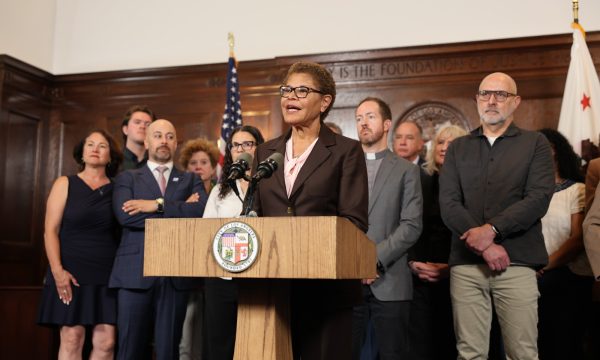Images Courtesy of LD Entertainment
In William Friedkin’s newest film, the legendary 76-year-old director has decided to release a movie even bolder than The Exorcist. The film features characters and events that push the boundaries in pretty much every MPAA regulated category. It is violent, disgusting, crude, and has subsequently been branded with an NC-17 rating, placing it alongside the likes of Showgirls (1995) and Mysterious Skin (2004). Killer Joe is also an incredibly in-depth character study. The film supports a stellar cast headlined by Matthew McConaughey and Emile Hirsch, excellent directing from William Friedkin, and seamless storytelling due to the penmanship of Tracy Letts. As the film progresses, the violence slowly crescendos in a completely plausible manner so that when the brutal gore begins to spew, the audience has no other option but to believe that bloody destruction is the only way out. Unlike films like Hostel and Saw, which are equally as graphic yet are somehow labeled ‘R’, Killer Joe has the storyline to back up the violence. With that being said, why has Killer Joe been cast out by the movie rating gods? The NC-17 rating pretty much means death at the box office. The highest grossing NC-17 film of all time, the aforementioned Showgirls, made just over $20 million domestically back in the mid-1990s. Thankfully the producers behind the movie did not decide to tone down the film and re-release it as ‘R’. While it could definitely have been done, the effects of the film truly hit home the most when viewing this un-edited tour de force from one of America’s finest directors. In essence, watching Killer Joe is a lot like staring directly into the sun; both leave residual images seared into one’s eyes long after turning away. And in this case, that’s a good thing.
Killer Joe tells the story of Chris (Emile Hirsch), a 22 year-old Dallas native who finds himself in debt to a local drug lord. Instead of going out and finding an actual paying job, like a normal person, Chris adheres to the redneck stereotype Hirsch so excellently embodies and decides to concoct a horribly outlandish get-rich-quick scheme. Chris’ first instinct is to hire the hit man Killer Joe (Matthew McConaughey) in order to kill his own mother and collect her $50,000 life insurance policy. The only problem, Chris isn’t the beneficiary of the life insurance policy, his sister Dottie (Juno Temple) is. Oh, and the other problem, Killer Joe requires his payment of $25,000 upfront. Chris, of course, doesn’t have $1,000 let alone $25,000 to pay Joe, so the hit man decides to take Chris’ sister as a retainer. As in any great dysfunctional family flick, a catalyst is needed to tip the scales and start the drama. Killer Joe acts as the boulder that flips the entire scale over.
One of the biggest differences between Killer Joe and other dysfunctional family dramas is its use of dark humor. The jokes in Killer Joe are so blasphemously dark, they border on black. In a perfect example of this style of humor, there is a scene in which Dottie discusses her past boyfriends with her stepmother Sharla, the excellent Gina Gershon. Dottie, like every character in the film, comes off as being a bit dull. She is a dreamer of the highest degree, and when Gina asks her how many boyfriends she has had, the girl responds that her last boyfriend was a fat kid from her third grade class. The humor from the scene derives from the fact that we have already seen Dottie’s exposed body multiple times in the film, so the audience assumes that Dottie is at least 18 years old. An 18 year-old girl whose last boyfriend was a fat kid from her third grade glass is funny, right? The audience later finds out that Dottie is only 12 years old. Cringe worthy humor such as this is sprinkled throughout the film.
This is not the first time Killer Joe has taken center stage. Tracy Letts originally wrote the story Killer Joe for the theater before adapting it to screen. The play was a huge success both in America and Internationally. It was voted Time Out’s Best Play of 1995, and successfully filled many nights at the 200-seat SoHo Playhouse in New York City. In any play that is adapted to cinema, dialogue takes an important role. Film version of plays like Glengarry Glen Ross and, reaching way back to 1989, Driving Miss Daisy feature very dialogue based scripts. When watching Killer Joe, there are moments when the audience can almost feel themselves being transported out of their movie theater seat and into the standing room section at a crowded West End theatre. A lot of the action, and definitely the tensest moments of the film come from Joe’s excellent monologues, which are preformed to perfection by McConaughey.
Having a great script is only half the battle. Director William Friedkin’s ability to give life to Letts’ words proves to be the biggest asset to the film. Friedkin clearly saw the cinematic potential of the play, and pulls the best aspects out of the theater version and expands them into a full on cinematic experience. Friedkin’s ability to extract the dark hues of the interiors and exteriors, the excellent music composing of Tyler Bates (300 and Watchmen), and effective editing by Darrin Navarro (Coach Carter, Rules of Engagement) all mesh perfectly together.
Over a dark screen, Killer Joe opens with the excruciatingly loud sound of Joe’s golden Zippo flicking open and closed with metronome like synchronization. Joe’s lighter remains the loudest sound effect in the film. Louder than the barking dogs, gun shots, and countless amounts of domestic violence. Much like the act of lighting one of the many amounts of cigarettes Joe smokes during the film, the movie as a whole is a lot like the slow burn of a cigarette. The flame works its way slowly to the butt, then gets stomped out by the hit man who lends his name to the title of the film.
By David Morris














